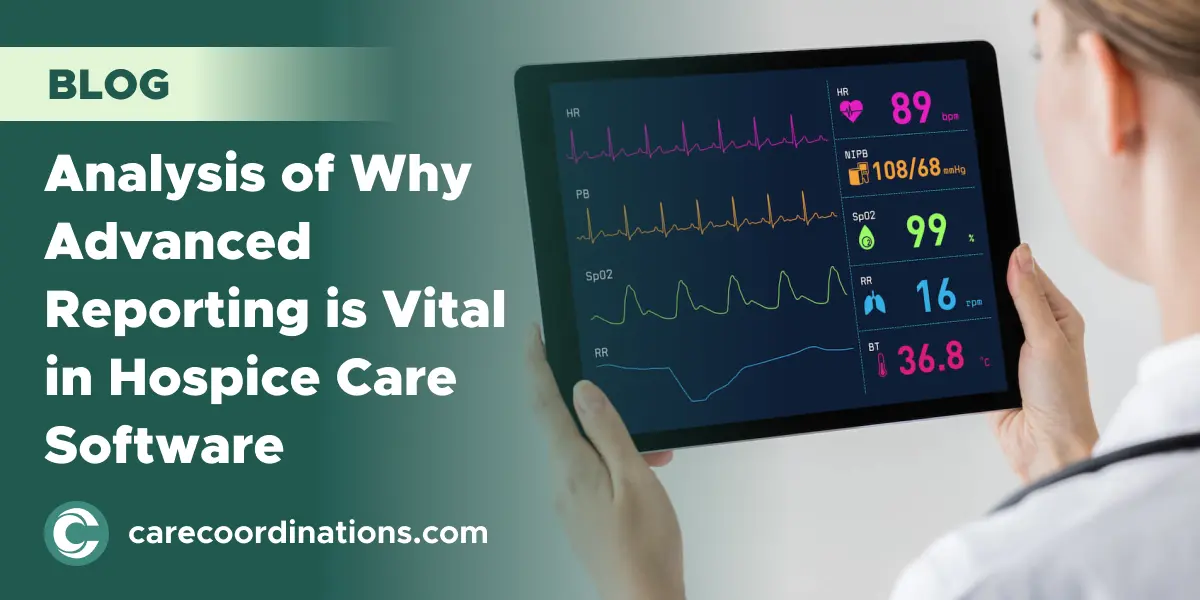Hospice care, a pivotal component of the healthcare industry, offers compassionate support to terminally ill patients and their families. According to the National Hospice and Palliative Care Organization (NHPCO), over 1.3 million patients in the United States received hospice care in 2020. This number is expected to grow significantly in the coming years, highlighting the increasing need for efficient and effective hospice services.
Technology, especially hospice care software solution, plays a crucial role in enhancing these services. Advanced reporting within this software emerges as a key feature, offering deep insights and improving patient care through data-driven decisions.
The Importance of Data in Hospice Care
Understanding Patient Needs
Data plays a pivotal role in shaping hospice care, allowing caregivers to craft personalized care plans that meet the unique needs of each patient. By meticulously tracking a patient's progress, healthcare providers can adjust treatments in real-time, ensuring that care is both compassionate and responsive.
Enhancing Care Quality
Data-driven insights are crucial for monitoring and improving the quality of care in hospice settings. Advanced reporting tools help track key quality indicators, such as symptom management effectiveness and patient satisfaction, facilitating continuous improvement in care delivery.
Operational Efficiency
Leveraging data enhances operational efficiency in hospice care by streamlining administrative duties, thus allowing healthcare professionals to dedicate more time to patient care. Effective use of data aids in optimizing resource distribution and staff scheduling, ensuring that the right care is delivered at the right time by the right person.
Also Read: Leading the Way: Innovative Software Solutions Paving the Path for Hospice Care in 2024
Advanced Reporting Features in Hospice Care Software
Real-time Analytics: The Power of Immediate Data
Real-time analytics in hospice care software transforms patient care by providing instant insights into patient conditions, treatment responses, and care needs. This immediacy allows healthcare providers to make informed decisions swiftly, enhancing the quality of care. Case studies reveal significant improvements in patient outcomes and operational efficiency when teams utilize real-time data, highlighting its critical role in hospice settings.
Customizable Reports: Tailoring Insights to Needs
Customizable reports offer the flexibility to focus on specific aspects of hospice care, from patient progress to resource allocation. This adaptability ensures that care providers can pinpoint areas requiring attention, streamline operations, and enhance patient care quality. Examples include detailed patient comfort levels and staff performance metrics, demonstrating the profound impact tailored reports can have on both patients and hospice management.
Compliance and Regulatory Reporting: Streamlining Complexity
Navigating the intricate landscape of compliance and regulations is simplified with advanced reporting features in hospice care software. Automated reporting tools ensure that hospices adhere to healthcare standards and regulations effortlessly, mitigating risks and enhancing operational transparency. This aspect of advanced reporting not only safeguards against non-compliance but also reinforces the commitment to providing high-quality care.
The Impact of Advanced Reporting on Patient Care and Outcomes
Personalized Care Plans
Advanced reporting in hospice care software significantly enhances the personalization of care plans. By leveraging detailed data, caregivers can understand patient preferences and end-of-life wishes more deeply, tailoring care to meet individual needs. This data-driven approach ensures that every aspect of care is aligned with the patient's desires, improving their quality of life.
Improved Patient and Family Satisfaction
Transparent reporting fosters better communication with families, keeping them informed and involved in the care process. Through real-life case examples, we see how advanced reporting tools have directly led to increased satisfaction among patients and their families, by making information accessible and understandable.
Outcome Improvement
Recent studies demonstrate a clear link between the use of advanced reporting in hospice care and improved patient outcomes. Statistical evidence highlights significant enhancements in symptom management and emotional support. Looking forward, the potential of data analytics promises even greater advancements in personalized care, setting a new standard for hospice services.
Also Read: User-Friendly Hospice Care Solutions: Ensuring Ease For Medical Staff
Overcoming Challenges in Implementing Advanced Reporting in Hospice Care Software
Data Security and Privacy
In the realm of hospice care software, safeguarding patient data is paramount. Addressing concerns related to data security and privacy involves implementing robust encryption methods, access controls, and regular security audits. Best practices include training staff on data privacy laws and ensuring compliance with regulations like HIPAA, thereby protecting sensitive information and building trust among users.
Training and Adoption
Introducing advanced reporting tools requires a thoughtful approach to training and adoption. Effective strategies include creating engaging, easy-to-understand training materials and workshops. To overcome resistance to change, highlighting the benefits of advanced reporting, such as improved patient care and operational efficiency, can encourage staff to embrace these tools. Regular feedback sessions can also help in refining the software features to meet user needs better.
Looking Ahead: The Future of Hospice Care Software
Technological Advancements
As we peer into the horizon, the integration of emerging technologies in hospice care software heralds a transformative era. Artificial Intelligence (AI) and Machine Learning are at the forefront, poised to revolutionize reporting capabilities. These advancements promise not only enhanced efficiency but also deeper, more meaningful insights into patient care, enabling personalized and compassionate end-of-life experiences.
Integrating Patient and Provider Feedback
The heart of innovation lies in the feedback from those it serves. In the realm of hospice care software, incorporating insights from patients and providers is crucial for continuous improvement. This collaborative approach has already begun to shape the evolution of reporting features, making them more intuitive and responsive to the needs of users. By listening and adapting, the future of hospice care software looks not only brighter but also more attuned to the human touch that defines its purpose.
Also Read: The Future of Hospice Care in 2024 and Beyond
Embrace the Future: Elevate Hospice Care with Advanced Reporting Now
In conclusion, advanced reporting in hospice software solutions is not just a feature—it's a necessity. It illuminates the intricacies of care, ensuring that every decision enhances patient comfort and dignity. As technology evolves, its integration into hospice care continues to revolutionize how we support those at life's end, fostering a seamless blend of compassion and efficiency. Embracing these technological advancements is crucial for delivering heartfelt, effective end-of-life care, demonstrating our commitment to excellence and empathy in every moment that matters.


